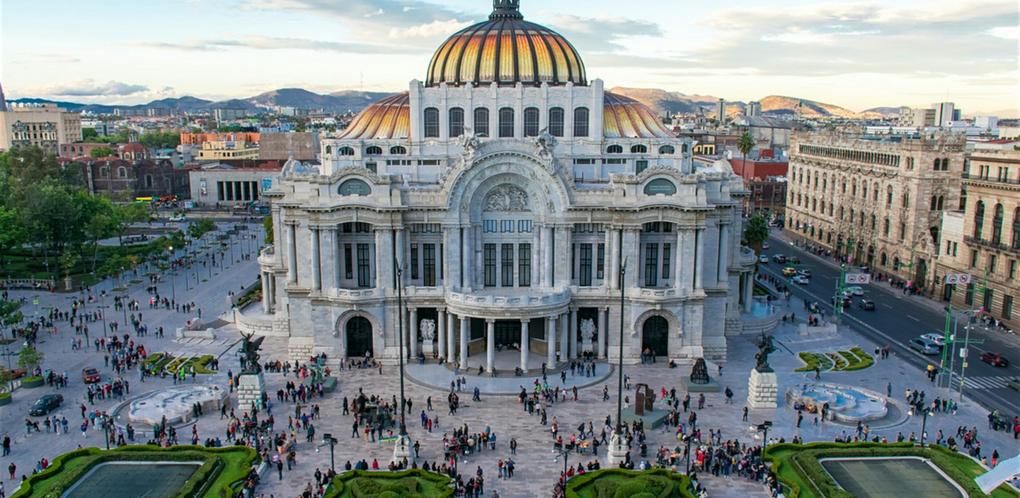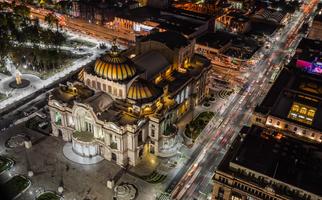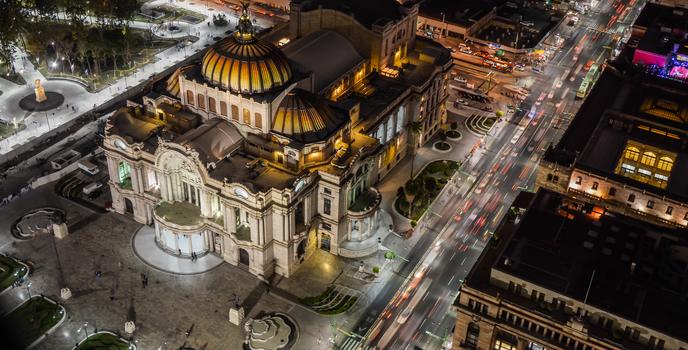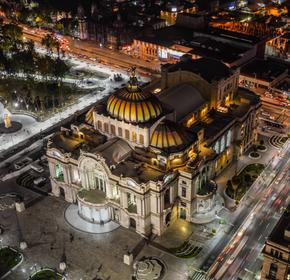
Mexico City travel guide
Mexico City Tourism | Mexico City Guide
You're Going to Love Mexico City
Mexico's largest city and capital may be massive, but it isn't hard to love. This major world city offers history, art, great food, shopping and family attractions plus it's easy to get around, beautiful and packed with high-quality accommodation.

Visiting Mexico City is a chance to step into a completely different culture. Explore the riches of Mexican food culture at gourmet restaurants like Izote or El Cardenal. Watch the Day of the Dead celebrations or the Semana Santa procession, or take salsa dancing classes at a downtown studio.
The city also has more than 800 years of history. Explore the world of the ancient Aztecs, wonder at the immensity of the Zocalo and the Metropolitan Cathedral and tour the palaces of the Centro Historico. Or just forget about culture and head to the boutiques in Polanco or the Six Flags Mexico amusement park.
Whether you want to immerse yourself in Mexican culture or enjoy a conventional family vacation, Mexico City is waiting for you touch down. You won't be disappointed.
Top 5 Reasons to Visit Mexico City
A Fascinating History
Mexico City is unique. Built directly upon the capital of the Aztec Empire, it was constructed as a statement of power and intent by the conquering Spanish. Find out about its ancient past, the colonial era and the Mexican Revolution at sites like the Palacio Nacional, the Templo Mayor and the immense Metropolitan Cathedral.
Artistic Treasures Everywhere you Look
Mexico City isn't just about beautiful architecture. Tour the murals by Diego Rivera, head to the Frida Kahlo museum or see the stunning frescos by Orozco at the San Ildefonso Museum. That's before you get the chance to head to huge institutions like the Museum of Modern Art. Art fans will be in heaven.
Wonderful Food from all over the World
Mexico City is somewhere all lovers of Mexican food simply need to visit. Whether it's the tacos at the stalls of the Mercado de la Merced or the gourmet creations of chefs at upscale eateries like El Cardenal, you'll never have tasted anything like it.
Public Transportation that makes Getting Around Simple
Mexico City is enormous, with a population exceeding 20 million people, but that doesn't mean it's hard to navigate. In fact, thanks to the Metro, buses, trolleys and light rail systems, reaching the major attractions couldn't be easier.
Family Attractions to Delight Kids and Adults
Don't assume that Mexico City is just for adults. Far from it. Kids will adore the animals at Chapultepec Zoo and the boating lake in the nearby park, while amusement parks like Six Flags Mexico offer enough rides to fill any rainy day with fun.
What to do in Mexico City
1. Museo Nacional de Antropología: Discover Mexico's Past
Stretching out over two stories with dozens of halls to explore, the Archaeological Museum bears witness to Mexico's incredible heritage. Enter and you'll find that much of the museum's grounds are easy for English-speakers to navigate. Free guided tours in English offer a unique opportunity to learn from an expert. As you stroll through the halls, you'll pass through the pre-Classic, Classic and Colonial periods.
2. Plaza de la Constitucion: Visit One of the World's Largest City Squares
Step into the Zócalo, as this massive plaza is known, and you stand where the Aztecs met hundreds of years ago. In use for centuries, the square is Mexico City's greatest gathering place. It's home to markets, festivals, concerts and protests, and according to Aztec legend, it's also the center of the universe. The plaza contains some of the most important buildings in the entire country, including the Cathedral and National Palace. A visit is sure to leave you wanting more.
3. Palace of Fine Arts: Be Inspired
Sprawling over a massive complex that includes a theater, concert hall and art galleries, this museum is easily one of the greatest in the Americas. Murals by artists such as Diego Rivera and Jose Clemente Orozco grace the walls of balcony lobbies, while a colored glass curtain made by Doctor Atl hangs over the theater stage. The outside of the building is also deserving of comment -- it towers above visitors and boasts a huge dome. As you stroll around the grounds, you may note that the palace is a bit lower than the surrounding city. That's because its great weight bore the building 15 feet into the ground.
4. Templo Mayor: Visit Mexican Temples
Join the millions of visitors who have thronged to one of Mexico City's newer museums. The museum houses the former Main Temple of the Mexica peoples. Walk through the halls and you'll see exhibits that highlight the political, military, and aesthetic heritage of one of the greatest cities in all of the Americas. The entire complex requires a good amount of time to walk through, as the museum is four stories high and houses numerous artefacts that have been uncovered by historians and archaeologists in recent decades. It's simply a must for anyone who wants to understand the history of Mexico City.
5. Bosque de Chapultepec: The Greatest of the Great Outdoors
Mexico City can be a heady experience, which is why many visitors spend hours exploring the humongous Bosque de Chapultepec. One of the largest city parks in the Western Hemisphere, this incredible green space has walking and biking trails, a large lake and numerous picnic areas. In addition to trees, the park hosts the Museum of Anthropology, the Rufino Tamayo Museum and the city zoo. As you walk through the massive park, be sure to note the many fountains and artworks that decorate the paths. Those looking to escape the city should head to the western part of the park, where there are secluded canyons.


1. Museo Nacional de Antropología: Discover Mexico's Past
Stretching out over two stories with dozens of halls to explore, the Archaeological Museum bears witness to Mexico's incredible heritage. Enter and you'll find that much of the museum's grounds are easy for English-speakers to navigate. Free guided tours in English offer a unique opportunity to learn from an expert. As you stroll through the halls, you'll pass through the pre-Classic, Classic and Colonial periods.
2. Plaza de la Constitucion: Visit One of the World's Largest City Squares
Step into the Zócalo, as this massive plaza is known, and you stand where the Aztecs met hundreds of years ago. In use for centuries, the square is Mexico City's greatest gathering place. It's home to markets, festivals, concerts and protests, and according to Aztec legend, it's also the center of the universe. The plaza contains some of the most important buildings in the entire country, including the Cathedral and National Palace. A visit is sure to leave you wanting more.
3. Palace of Fine Arts: Be Inspired
Sprawling over a massive complex that includes a theater, concert hall and art galleries, this museum is easily one of the greatest in the Americas. Murals by artists such as Diego Rivera and Jose Clemente Orozco grace the walls of balcony lobbies, while a colored glass curtain made by Doctor Atl hangs over the theater stage. The outside of the building is also deserving of comment -- it towers above visitors and boasts a huge dome. As you stroll around the grounds, you may note that the palace is a bit lower than the surrounding city. That's because its great weight bore the building 15 feet into the ground.
4. Templo Mayor: Visit Mexican Temples
Join the millions of visitors who have thronged to one of Mexico City's newer museums. The museum houses the former Main Temple of the Mexica peoples. Walk through the halls and you'll see exhibits that highlight the political, military, and aesthetic heritage of one of the greatest cities in all of the Americas. The entire complex requires a good amount of time to walk through, as the museum is four stories high and houses numerous artefacts that have been uncovered by historians and archaeologists in recent decades. It's simply a must for anyone who wants to understand the history of Mexico City.
5. Bosque de Chapultepec: The Greatest of the Great Outdoors
Mexico City can be a heady experience, which is why many visitors spend hours exploring the humongous Bosque de Chapultepec. One of the largest city parks in the Western Hemisphere, this incredible green space has walking and biking trails, a large lake and numerous picnic areas. In addition to trees, the park hosts the Museum of Anthropology, the Rufino Tamayo Museum and the city zoo. As you walk through the massive park, be sure to note the many fountains and artworks that decorate the paths. Those looking to escape the city should head to the western part of the park, where there are secluded canyons.


Where to Eat in Mexico City
If you have ever developed a taste for Mexican food, prepare to be dazzled. Mexico City offers the widest choice of gourmet Mexican eateries on the planet. Some of the best upscale restaurants include El Cardenal in the Sheraton Centro Historico and Los Girasoles. Bakery El Globo is a good place to pick up a snack, as are the street food stalls at the Mercado de la Merced. Don't miss local delicacies like pozole (pork stew) or arrachera (hanger steak). Leave some space for a taco or two as well from cafes and restaurants like Cafe Tacuba, and El Bajio. Expect to pay around MXN 50 at places like Sanborn's up to MXN 200 at the most exclusive restaurants.
When to visit Mexico City
Summers in Mexico City aren't the best time to go, with regular rains and hot, humid weather. Winter gets a little chilly, and the weather is unreliable, leaving spring and fall as the best times to go. Head to the city in May and June for the best weather, events like the Semana Santa procession and smaller crowds than July and August.
How to Get to Mexico City
Plane
The easiest way to get to Mexico City is via Benito Juarez International Airport which is just to the east of the city center and receives daily flights from US cities like Los Angeles, Houston and New York. When you arrive, the best route into the city is via Metro Line 5 which runs from Terminal 1 and costs MXN 5. You'll need to change onto Line 1 at Pantitlan, two stops from the airport. After that, it's a 20-minute journey to central stations like Chapultepec.
Car
It is possible to drive all the way from the US border to Mexico City, but few visitors choose to do so. If you do choose to drive, the quickest route from the western USA is to take Highway 40D from Laredo and to change onto Highway 57 at Saltillo.
Bus
If you want to save money or see the Mexican scenery unfold, taking a bus to Mexico City is another good option, and Greyhound offers plenty of connections from US cities (in conjunction with Mexican operators like Autobus Americanos or Grupo ADO.
Airlines serving Mexico City
Where to stay in Mexico City
Centro Historico – The Centro Historico is the oldest neighborhood in Mexico City and has been around in some form for 800 years or more. When the Spanish arrived, they turned the core of the Aztec capital into a beautiful political, religious and cultural center, and it's still a gorgeous area to wander around. Local highlights include the massive Zocalo square, the site of the Aztec temple and the Palacio National, with its murals by Diego Rivera.
Popular Neighborhoods in Mexico City
Polanco – Mexico City's most upmarket area, Polanco is mainly an elegant residential area, with plenty of hotels for luxury vacationers to stay in. It's also the premier dining district, with leading restaurants like Izote, as well as a cultural hub thanks to sites like the Cinemex Casa de Arte.
Zona Rosa – Zona Rosa attracts millions of visitors thanks to its wealth of entertainment options. The city's nightlife center, with bars like Lollipop and eateries like Beatricita, Zona Rosa is the place to go when the sun sets. Check out the large cluster of Korean restaurants for another side of life in Mexico City and the many LGBT bars in the area.
Where to stay in popular areas of Mexico City
Most booked hotels in Mexico City
How to Get Around Mexico City
Public Transportation
The 12 lines of the Mexico City Metro are the best way to get around the city's major attractions and cover pretty much everywhere you might need to go. Tickets cost MXN 5 no matter where you intend to go, and trains arrive every 2 minutes, so waiting around isn't a problem. However, overcrowding can be. Try to travel outside peak hours and always carry water as the system can get very hot at times. Aside from the Metro, you can also take large and small buses which cost MXN 2 and MXN 3 respectively (and require exact change). Trolley buses cost MXN4 and light rail fares are MXN 3 - so there are always plenty of options.
Taxis
If you want to get around without rubbing shoulders with commuters, taxis are plentiful and cheap. There's a fixed meter drop of MXN 9, then a charge of MXN 8.05 per mile after that. Uber is also present in Mexico City and offers an even cheaper way to get around, with UberX vehicles charging MXN 7 for the meter drop, then MXN4.50 per mile.
Car
Because of the quality of the public transportation network and the difficulty of navigating Mexico City's streets, few tourists benefit from having a car unless they intend to travel outside the city. If you do want to drive, you can rent vehicles from outlets like Sixt, Avis and Hertz for around MXN 200 per day.
The Cost of Living in Mexico City
Shopping Streets
If you are looking for high-end boutiques, Polanco is easily the best area to visit. Ave Presidente Masaryk is the most vibrant shopping street in the area, and is home to stores like Raquel Orozco, the art boutique Histeria and specialty stores like Baby Deli. Condesa offers a more bohemian vibe, with fashion bargains aplenty of local favorites like Suite 66, while Pino Suarez market specializes in youth-fashion and offers rock-bottom prices.
Groceries and Other
Some of the leading grocery chains in Mexico City include familiar names like CostCo and Walmart, along with Mexican stores like Superama and Soriana. All of them offer cheap food and drink, making the city a great place to self-cater. However, a more exciting grocery shopping experience can be enjoyed at Mercado de la Merced, where fresh produce jostles with street food vendors. Prices in Mexico City are very low by US standards. Expect to pay MXN 60 for a gallon of milk and MXN 25 for 12 eggs.

